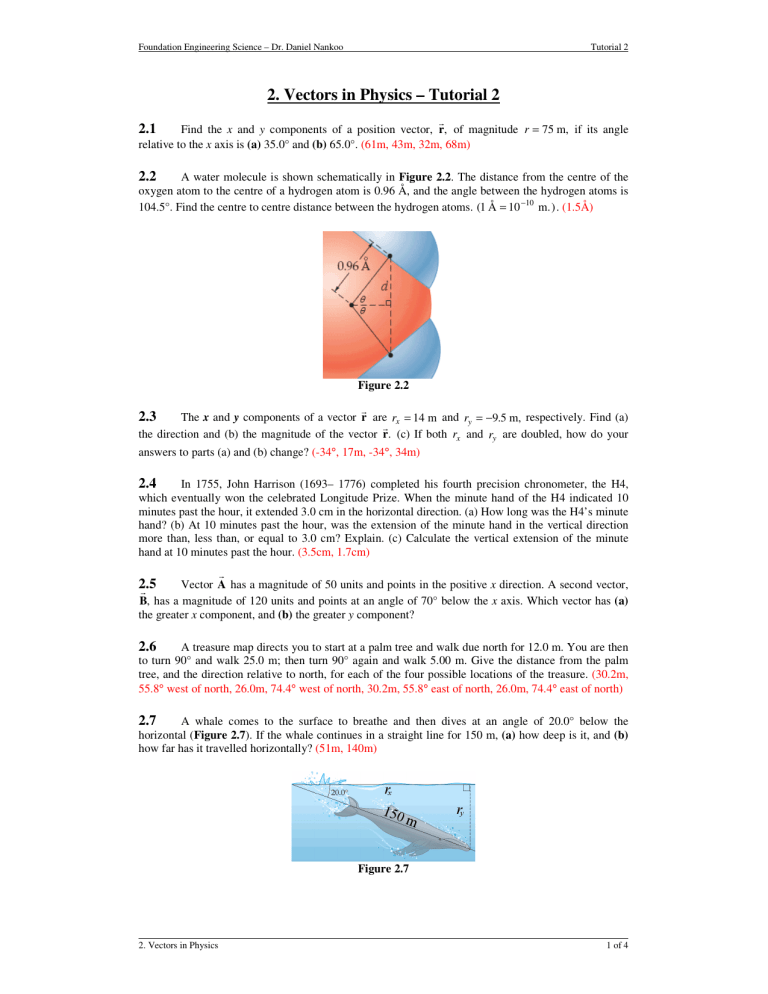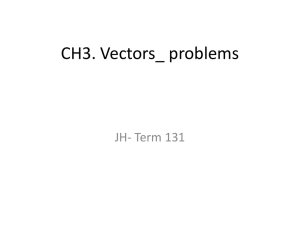2. Vectors in Physics – Tutorial 2

Foundation Engineering Science – Dr. Daniel Nankoo Tutorial 2
2. Vectors in Physics – Tutorial 2
2.1
Find the x
and y
components of a position vector, r r
, of magnitude r =
75 m, if its angle relative to the x
axis is
(a)
35.0° and
(b)
65.0°. (61m, 43m, 32m, 68m)
2.2
A water molecule is shown schematically in
Figure 2.2
. The distance from the centre of the oxygen atom to the centre of a hydrogen atom is 0.96 Å, and the angle between the hydrogen atoms is
104.5°. Find the centre to centre distance between the hydrogen atoms. (1 Å
=
10 −
10 m.) . (1.5Å)
Figure 2.2
2.3
The x
and y
components of a vector r r
are r the direction and (b) the magnitude of the vector x
=
14 m and r y r r
. (c) If both r x
= −
9 5
and r y
respectively. Find (a)
are doubled, how do your answers to parts (a) and (b) change? (-34
°
, 17m, -34
°
, 34m)
2.4
In 1755, John Harrison (1693– 1776) completed his fourth precision chronometer, the H4, which eventually won the celebrated Longitude Prize. When the minute hand of the H4 indicated 10 minutes past the hour, it extended 3.0 cm in the horizontal direction. (a) How long was the H4’s minute hand? (b) At 10 minutes past the hour, was the extension of the minute hand in the vertical direction more than, less than, or equal to 3.0 cm? Explain. (c) Calculate the vertical extension of the minute hand at 10 minutes past the hour.
(3.5cm, 1.7cm)
2.5
Vector r
A
has a magnitude of 50 units and points in the positive x
direction. A second vector, r
B
, has a magnitude of 120 units and points at an angle of 70° below the x
axis. Which vector has
(a) the greater x
component, and
(b)
the greater y
component?
2.6
A treasure map directs you to start at a palm tree and walk due north for 12.0 m. You are then to turn 90° and walk 25.0 m; then turn 90° again and walk 5.00 m. Give the distance from the palm tree, and the direction relative to north, for each of the four possible locations of the treasure. (30.2m,
55.8
°
west of north, 26.0m, 74.4
°
west of north, 30.2m, 55.8
°
east of north, 26.0m, 74.4
°
east of north)
2.7
A whale comes to the surface to breathe and then dives at an angle of 20.0° below the horizontal (
Figure 2.7
). If the whale continues in a straight line for 150 m,
(a)
how deep is it, and
(b) how far has it travelled horizontally? (51m, 140m)
2. Vectors in Physics
Figure 2.7
1 of 4
Foundation Engineering Science – Dr. Daniel Nankoo Tutorial 2
2.8
axis.
(a)
A vector r
A
has a magnitude of 50.0 m and points in a direction 20.0° below the positive x axis. A second vector, r
B
, has a magnitude of 70.0 m and points in a direction 50.0° above the positive x
Sketch the vectors r r
A B r r r
C = A + r
B
.
(b)
Using the component method of vector addition, find the magnitude and direction of the vector
C
. (99.0m, 21.7
°
)
2.9
An air traffic controller observes two aeroplanes approaching the airport. The displacement from the control tower to plane 1 is given by the vector
A
, which has a magnitude of 220 km and r r
A
,
− B
, r
B
, which has a magnitude of 140 km and points 65° east of north.
(a)
Sketch the vectors
and r r r
D = A − B
. Notice that magnitude and direction of the vector r r
D
is the displacement from plane 2 to plane 1.
(b)
Find the
D
.
(320km, 10
°
north of west)
2.10
C = r
A +
Vector
B r
A
points in the positive
points in the positive y x
direction and has a magnitude of 95 m.
Estimate the magnitude and direction of the vector r
(a)
Sketch r r
A B C
.
(b)
B
.
(c)
Verify your estimate in part (b) with a numerical calculation. (121m, 128
°
)
2.11
A + B
,
Vector
(b) r
A
points in the negative y
direction and has a magnitude of 5 units. Vector r r
A − B
, and
(c) r r
B − A
. (11 units, -27
°
, 11 units, 207
°
, 11 units, 27
°
) r
B
has twice the magnitude and points in the positive x
direction. Find the direction and magnitude of
(a)
2.12
A basketball player runs down the court, following the path indicated by the vectors r
C
in
Figure 2.12
. The magnitudes of these three vectors are A
= m, B
=
20 0 m, and C r r
A B
=
7 0 m.
Find the magnitude and direction of the net displacement of the player using
(a)
the graphical method and
(b)
the component method of vector addition. Compare your results. (20m, 1.5
°
, 20.2m, 1.8
°
)
Figure 2.12
2.13
A particle undergoes a displacement
∆ r r
of magnitude 54 m in a direction 42° below the x axis. Express
∆ r r
in terms of the unit vectors $ and y
.
(40m, -36m)
2.14
A vector component and
(b) r
A
has a length of 6.1 m and points in the negative x
direction. Find
(a)
the x
the magnitude of the vector
−
3 7 r
A
.
(23m, 23m)
2.15
Find the direction and magnitude of the vectors.
(a) r
A = m) x + −
2 0 r
(b) B
2 0
(c) r r
A + B
. m) x +
5 0
(-22
°
, 5.4m, 110
°
, 5.4m, 45
°
, 4.2m)
2. Vectors in Physics 2 of 4
Foundation Engineering Science – Dr. Daniel Nankoo Tutorial 2
2.16
Find the direction and magnitude of the vectors.
(a) r
A =
( 25 m) x + −
12
(b) r
B = m) x +
( 15
(c) r r
A + B
.
(-26°, 28m, 82°, 15m, 6.3°, 27m)
2.17
Express each of the vectors in
Figure 2.17
in unit vector notation.
([1.1, 0.96], [1.9, -0.65],
[-0.91, 0.42], [0, 1.5])
Figure 2.17
2.18
Referring to the vectors in
Figure 2.17
, express the sum
(2.1, 0.74) r r r
A + B + C
in unit vector notation.
2.19 In its daily prowl of the neighbourhood, a cat makes a displacement of 120 m due north, followed by a 72-m displacement due west.
(a)
Find the magnitude and direction of the displacement required for the cat to return home.
(b)
If the cat first prowls 72 m west and then 120 m north, how would this affect the displacement needed to bring it home? Explain. (140m, 59° south of east)
2.20
What is the direction and magnitude of your total displacement if you have travelled due west with a speed of 27 m/s for 130 s, then due south at 14 m/s for 62 s?
(14° south of west, 3.6km)
2.21 A jogger runs with a speed of 3.25 m/s in a direction 30.0° above the x
axis.
(a)
Find the x
and y
components of the jogger’s velocity.
(b)
How will the velocity components found in part (a) change if the jogger’s speed is halved? (2.81m/s, 1.63m/s)
2.22
You throw a ball upward with an initial speed of 4.5 m/s. When it returns to your hand 0.92 s later, it has the same speed in the downward direction (assuming air resistance can be ignored). What was the average acceleration vector of the ball?
(-9.8m/s 2 , y
direction)
2.23
A skateboarder rolls from rest down an inclined ramp that is 15.0 m long and inclined above the horizontal at an angle of
θ =
20 0 is 10.0 m/s. Show that the average acceleration of the skateboarder is g sin , where g =
.
(3.33m/s 2 , 3.36m/s 2 ) m/s 2 .
2. Vectors in Physics 3 of 4
Foundation Engineering Science – Dr. Daniel Nankoo Tutorial 2
2.24
Relative to the centre of the Earth, the position of the Moon can be approximated by r r =
( .
8
×
−
6 radians s t x + ×
−
6 radians s t y
} where t
is measured in seconds.
(a)
Find the magnitude and direction of the Moon’s average velocity between t =
0 and t =
7 38 days. (This time is one-quarter of the 29.5 days it takes the Moon to complete one orbit.)
(b)
Is the instantaneous speed of the Moon greater than, less than, or the same as the average speed found in part (a)? Explain.
(852m/s, 135°)
2.25
The velocity of the Moon relative to the center of the Earth can be approximated by r v =
( 945 m s ) {
− ×
−
6 radians s t x + ×
−
6 radians s t y
} where t
is measured in seconds. To approximate the instantaneous acceleration of the Moon at calculate the magnitude and direction of the average acceleration between the times
(a) t =
0 100 days and
(b) t =
0 and t =
0 0100 orbit is 29.5 days).
(-0.00233m/s 2 ) t =
0, t =
0 and
days. (The time required for the Moon to complete one
, -0.00233m/s 2
2.26
As an aeroplane taxies on the runway with a speed of 16.5 m/s, a flight attendant walks toward the tail of the plane with a speed of 1.22 m/s. What is the flight attendant’s speed relative to the ground?
(15.3m/s)
2.27 As you hurry to catch your flight at the local airport, you encounter a moving walkway that is
85 m long and has a speed of 2.2 m/s relative to the ground. If it takes you 68 s to cover 85 m when walking on the ground, how long will it take you to cover the same distance on the walkway? Assume that you walk with the same speed on the walkway as you do on the ground. (25s)
2.28
The pilot of an aeroplane wishes to fly due north, but there is a 65 km/h wind blowing toward the east.
(a)
In what direction should the pilot head her plane if its speed relative to the air is 340 km/h?
(b)
Draw a vector diagram that illustrates your result in part (a).
(c)
If the pilot decreases the air speed of the plane, but still wants to head due north, should the angle found in part (a) be increased or decreased? (11° west of north)
2.29
A passenger walks from one side of a ferry to the other as it approaches a dock. If the passenger’s velocity is 1.50 m/s due north relative to the ferry, and 4.50 m/s at an angle of 30.0° west of north relative to the water, what are the direction and magnitude of the ferry’s velocity relative to the water? (43° west of north, 3.29m/s)
2.30
You are riding on a Jet Ski at an angle of 35° upstream on a river flowing with a speed of 2.8 m/s. If your velocity relative to the ground is 9.5 m/s at an angle of 20.0° upstream, what is the speed of the Jet Ski relative to the water? (11m/s)
2.31
In 2.30, suppose the Jet Ski is moving at a speed of 12 m/s relative to the water.
(a)
At what angle must you point the Jet Ski if your velocity relative to the ground is to be perpendicular to the shore of the river?
(b)
If you increase the speed of the Jet Ski relative to the water, does the angle in part (a) increase, decrease, or stay the same? Explain.
(13°)
2.32
Two people take identical Jet Skis across a river, travelling at the same speed relative to the water. Jet Ski A heads directly across the river and is carried downstream by the current before reaching the opposite shore. Jet Ski B travels in a direction that is 35° upstream and arrives at the opposite shore directly across from the starting point.
(a)
Which Jet Ski reaches the opposite shore in the least amount of time?
(b)
Confirm your answer to part (a) by finding the ratio of the time it takes for the two Jet Skis to cross the river.
(0.82)
2. Vectors in Physics 4 of 4



